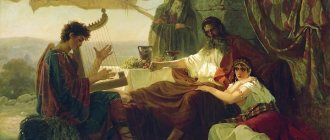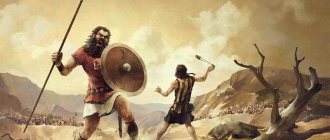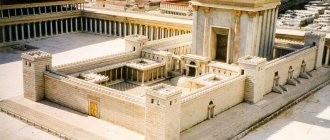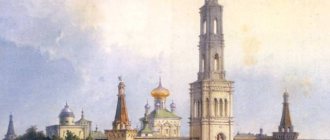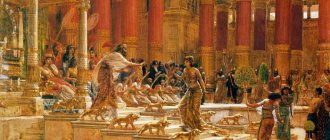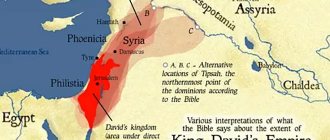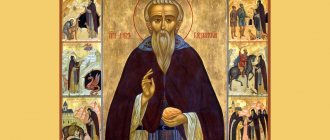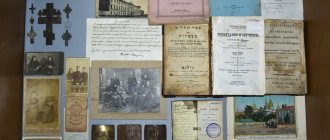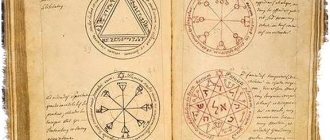The most revered ruler of Georgia is King David Agmashenebeli (Builder)
David IV the Builder (1073-1125) - Georgian king from the Bagrationi dynasty, son of George II. A pupil of the Monk Arseny of Ikaltoy, he ascended the throne at the age of 16.
He received a country razed to the ground during the “great Turkish invasion,” and left his heir an empire stretching between two seas.
The Orthodox Church of Georgia canonized David the Builder as a blessed king at the end of the 13th century, making an exception to the rule of canonizing only martyrs and saints.
Uniter
David IV ascended the throne in 1089, during a period of difficult situation in Georgia. At that time, tsarist power actually extended only to Western Georgia.
Having taken over the rule of the country devastated and devastated by the invaders, the young king began painstaking work to recreate the army - he multiplied and equipped the army, trained soldiers. The territory controlled by the king gradually expanded and the people returned to their abandoned homes.
One of the most prominent statesmen of medieval Georgia, during his 36-year reign, David IV put an end to feudal strife, brought Georgia out of a state of complete ruin, united and strengthened Georgia, created a regular army, and made the country independent and strong. Thus, he made an invaluable contribution to the history of the country.
It was he who in 1122 liberated Tbilisi, which had been ruled by Muslim rulers for several centuries, and moved the capital there from Kutaisi.
The wise king understood that it was not so easy to dramatically change the entire way of life that existed in Tbilisi before his liberation. Therefore, Christians, in particular, were prohibited from slaughtering pigs in areas of the city where Muslims lived.
David the Builder, a faithful son of the Orthodox Church, strove to live in peace with all people, for which he won the respect of not only Orthodox Georgians, but also those of other faiths. He invariably took care of strengthening and protecting the Church, but at the same time provided protection and care to all his subjects.
Politician
In the time of David, the country did not know what peace was; the Georgians of that era were constantly holding in their hands either a sword, a pen, or a plow (depending on who was capable of what). The Georgian nation, under this great helmsman, turned into a colossal force.
David the Builder was an excellent strategist and wise politician. Thanks to this, he defeated the enemy, despite numerical superiority and other unfavorable factors for the Georgian side.
He could turn various unfavorable factors to his advantage. For example, he “tamed” some of the nomads who once carried out destructive raids on Georgia. As a result of the king's wise policy, they became his loyal warriors.
The constant threat of a new invasion from enemies and the expansion of state boundaries required the creation of a large regular army. And King David made a very unexpected decision - he resettled 40 thousand Polovtsians (Kipchaks) with their families, expelled by the Kyiv Grand Duke Vladimir Monomakh from the southern Russian steppes, to Georgia.
Best military leader
Georgian King David IV was an unsurpassed military leader. He topped the top ten best military generals of all time, according to one of the largest online surveys, The Top Tens.
In this list, David the Builder is followed by the commander Alexander the Great, the Vietnamese commander-in-chief Tran Hung Dao, the French commander Napoleon I Bonaparte, the Vietnamese general and politician Vo Nguyen Giap, the founder and first great khan of the Mongol Empire Genghis Khan, the Carthaginian commander Hannibal Barca, the ancient Roman statesman and politician Gaius Julius Caesar.
The ranking of generals is closed by one of the companions of the Prophet Muhammad, Khalid ibn al-Walid and the second emperor of the Vietnamese dynasty, Tay Son Nguyen Hue.
Builder
King David paid great attention to the construction of cities, palaces, roads, bridges, and caravanserais. During the reign of David IV, dozens of temples and monasteries were erected in Georgia, new cities were created and old cities were expanded. This is why he was nicknamed the Builder.
In 1103, on the initiative of David the Builder, a Church Council was convened in Ruisi (reiog of Shida Kartli), the resolutions of which contributed to the strengthening of the canonical life of the Church and the establishment of church deanery.
Reformer
David IV began his reign with the strengthening of power and authority. To centralize the country, the king tried to subordinate the princes to the central bureaucratic apparatus at the court created by the feudal monarchy. Eristavi even made the great ones themselves officials “on salary”, whom he transferred at any time to any region.
The young king multiplied the army, equipped it with weapons, horses and began training it. During exercises and small battles, he instilled faith in the soldiers in victory. He taught strategy and tactics of battles and reminded of the glorious victories of Georgian warriors. David banned foul language and obscene songs in the army and established ideal order. He introduced many innovations into the “design” of hikes. And the infantry troops were gradually replaced by cavalry units.
David introduced a tax rate depending on the type of activity a citizen of the country was engaged in. For example, farmers and livestock breeders paid much less than artisans. Merchants paid more than that.
Enlightener
David the Builder was not only an excellent warrior and strategist, but also an educator. He considered the education segment a priority and did everything to put this industry on its feet. David IV founded the Gelati and Ikaltoi academies, which became the most important center of philosophy and theology of that time.
If earlier Georgians went abroad to receive an education (to Mount Athos, Black Mountain, Mount Sinai and Jerusalem), then since then Georgians have been able to receive a full education at home.
Moreover, David IV returned enlightened compatriots who worked abroad to Georgia, entrusting them with the responsible task of educating future generations. In short, David laid the foundation for the great educational and cultural renaissance that took place in the era of George III (1156-1184) and Tamara (1184-1207).
David the Builder was buried in Gelati - at the entrance to the Gelati Monastery, which the king himself created 20 years before his death.
Are you going to Georgia? Write to [email protected] - we will create the optimal travel route for you. Come and we will try to make your vacation unforgettable! You can get a free consultation by phone: +7 (495) 268-07-72 or +995 555 566 540
Source: Sputnik Georgia
Content
- 1 Gaining power
- 2 Foreign policy 2.1 Annexation of Hereti-Kakheti
- 2.2 War with the Seljuks
- 5.1 Government system
Notes
- I. F. Polovtsy in Georgia and Vladimir Monomakh // From the history of Ukrainian-Georgian relations. Part 1. Tbilisi. 1968. P.23.
- Lives of the King of Kings David. Translation from ancient cargo. Notes and comments by Yu. Nasibov. // Medieval East: history and modernity. Ed. Z. M. Buniyatova. Baku. 1990. P.134
- Right there. pp. 134-135.
- that is, Armenia
- city in modern Azerbaijan
- Kartlis Tskhovreba, village. 332, 335-336.
- Konstantin Gamsakhurdia.
[books.google.com.ua/books?id=ii0-AQAAIAAJ&q=%22%D1%83+%D0%BD%D0%B5%D0%B3%D0%BE+%D0%B1%D1%8B%D0 %BB%D0%B0++%D0%B6%D0%B5%D0%BD%D0%B0+%D0%A0%D1%83%D1%81%D1%83%D0%B4%D0%B0%D0%BD %22&dq=%22%D1%83+%D0%BD%D0%B5%D0%B3%D0%BE+%D0%B1%D1%8B%D0%BB%D0%B0++%D0%B6%D0%B5 %D0%BD%D0%B0+%D0%A0%D1%83%D1%81%D1%83%D0%B4%D0%B0%D0%BD%22&source=bl&ots=FbAbBxFTYn&sig=2v1-k2LpRAsNSTSFEETJQgcVUFo&hl=ru&sa=X&ei =yb8PUKnEGMzIswa2v4GwCw&ved=0CDUQ6AEwAQ Abduction of the Moon]. — 1964. - Matthew of Edessa.
[www.vostlit.info/Texts/rus3/Matfei_II/text32.phtml Chronography]. [www.webcitation.org/69h5dBeDR Archived from the original on August 5, 2012].
Literature
- Anchabadze, G. Z.
Kypchaks in Georgia / G. Z. Anchabadze // Problems of modern Turkology: materials of the II All-Union Turkological Conference September 27–29, 1976, Alma-Ata. - Alma-Ata: Science of the Kazakh SSR, 1980. - 429 p. — pp. 342–344. - ბერძენიშვილი, ნ.
საქართველოს ისტორია : დამხმარე სახელმძღვანელ ო. 3 ტ. ტ. 1. უძველესი დროიდან XIX საუკუნის დასასრულამდე / ნ. ბერძენიშვილი, ვ. დონდუა, მ. დუმბაძე და სხვ. — თბ. : საბჭ. საქართველო, 1958. - 586 გვ. - ლორთქიფანიძე, მ.
საქართველო XI-XII საუკუნეებში / მ. ლორთქიფანიძე. — თბ. : განათლება, 1987. - 184 გვ. — გვ. 80-118. - ჩხატარაიშვილი, ქ.
1118 / ქ. ჩხატარაიშვილი // ქართული საბჭოთა ენციკლოპედია. 12 ტ. ტ. 10. ტიხუანა - შინდარა / მთ. რედ. ი. აბაშიძე. - თბ., 1986. - გვ. 642. - Golden, PB
Cumanica I: the Quipchaqs in Georgia / PB Golden // Archivum Eurasiae Medii Aevi IV. - Wiesbaden: Otto Harrassowitz, 1984. - 317 p. - P. 45-87. — ISBN 3-447-08527-4. - Khazanov, A. M.
Nomads in the Sedentary World / Ed. by Anatoly M. Khazanov and Andre Wink. — 1st ed. — [L.]: Routledge, 2001. — 295 p. — (Curzon-Iias Asian Studies). — ISBN 0-7007-1370-0. - Kırzıoğlu, MF
Yukarı Kür ve Çoruk Boylarında Kıpçaklar / MF Kırzıoğlu; Atatürk Universitesi, Erzurum. — İkinci baskı. - Ankara: Türk Tarih Kurumu Basımevi, 1992. - 278 s. — ISBN 9-751-60459-1. - Rapp, SH
Studies in Medieval Georgian Historiography: Early Texts and Eurasian Contexts / SH Rapp. - Leuven: Peeters Publishers, 2003. - 522 p. — (Corpus Scriptorum Christianorum Orientalium; vol. 601). — ISBN 90-429-1318-5. - Suny, RG
The making of the Georgian nation / RG Suny. — 2nd ed. - [Bloomington, IN]: Indiana University Press, 1994. - 418 p. — ISBN 0-253-20915-3. - Marie-Félicité Brosset, Histoire de la Géorgie depuis l'Antiquité jusqu'au s-|XIX|e, v.
1-7 . Saint-Petersbourg, 1848-58. (Lire ce livre avec Google Books: [books.google.com/books?vid=OCLC38657816&id=9PIKAAAIAAJ&dq=Brosset], [books.google.com/books?vid=OCLC38657816&id=RfMKAAAIAAJ&dq=Brosset])
Links
Eastern Georgia (1247–1308) David VII • Demeter II • David VIII • Vakhtang III • George V • George VI Western Georgia (1247—1308) David VI • Vakhtang II • Constantine I • Michael • Alexander • Alexander • George • Constantine II Unification (1346–1490) David IX • Bagrat V • George VII • Constantine I • Alexander I • Vakhtang IV • George VIII • Bagrat VI • Alexander II • Constantine II
Family
Konstantine Gamsakhurdia notes that it is not historically confirmed that before David’s marriage to the daughter of the Polovtsian leader Atrakha Sharaganovich - Gurandukht, he had a wife Rusudan, with whom he separated [7], although Matthew of Edessa, a 12th-century chronicler, reports that David had legitimate son named Demetrius, who was born from an Armenian woman[8].
Children:
- Tamara (d. 1155), princess, married to Shirvanshah Minuchikhr III (1120-1160);
- Demeter I (1093-1156), king of Georgia (1125-1156);
- Kata, princess, married to Tsarevich Isaac Komnenos, son of Emperor Alexei I;
- Rusudan, princess, married to the Ossetian king David II;
- George, Tsarevich.
- Vakhtang, prince (son of Gurandukht, daughter of the Kipchak ruler Atrok son of Sharakan).
Memory
The epithet Agmashenebeli (Georgian: აღმაშენებელი), which is translated as “Builder”[38], or “Restorer”[39]. The first mention of this epithet of King David appears in the charter issued in 1452 in the work “King of Kings Bagrat” and was firmly established in the works of historians of the 17th and 18th centuries, such as Parsadan Gorgidzhanidze, Beri Egnatashvili and Prince Vakhushti Bagrationi[40]. ] Epigraphic sources also indicate the early use of another epithet of King David - “Great” (Georgian: დიდი, didi)[41].
An avenue in Tbilisi is named after King David. Also, the International Airport of Kutaisi is named after King David the Builder.
